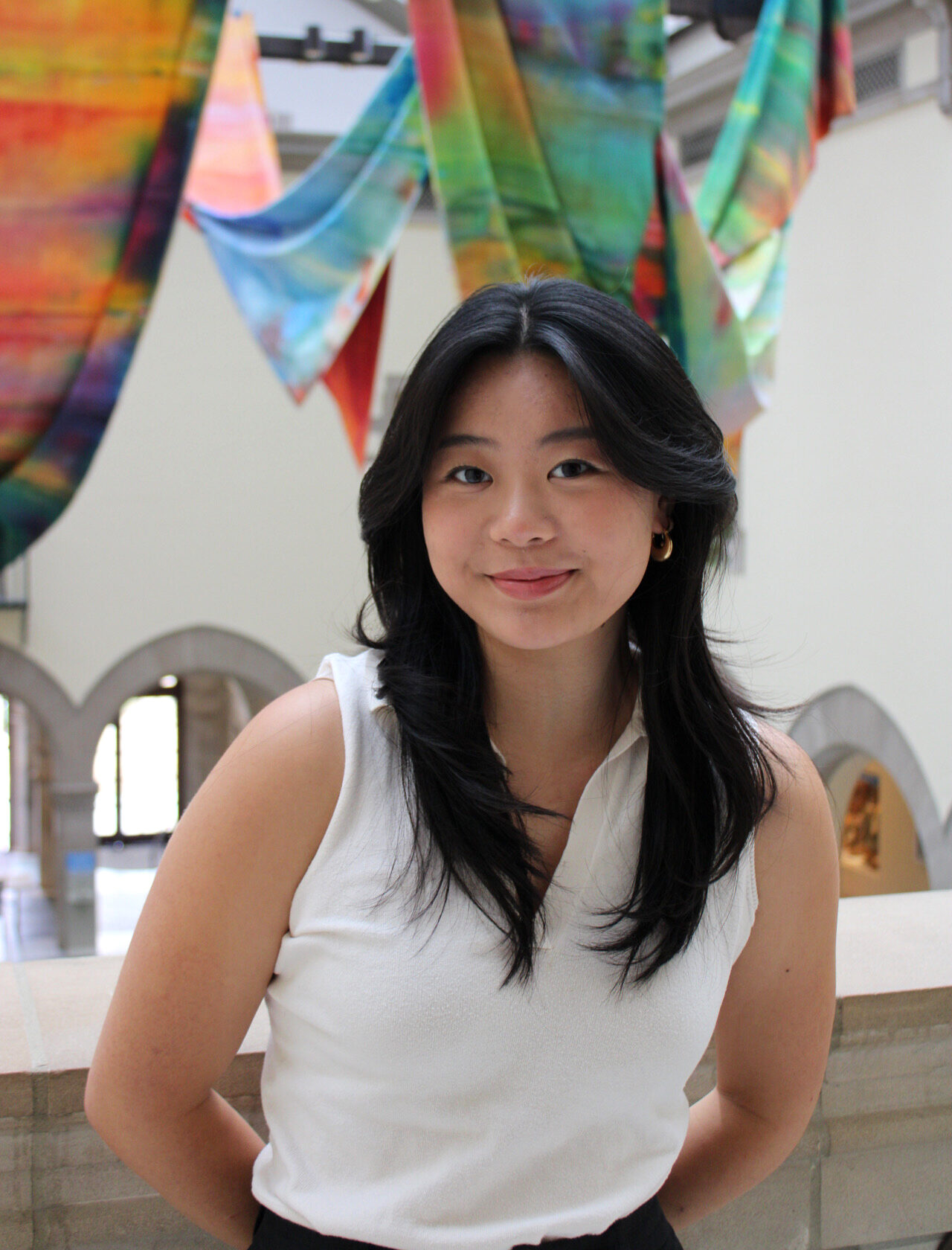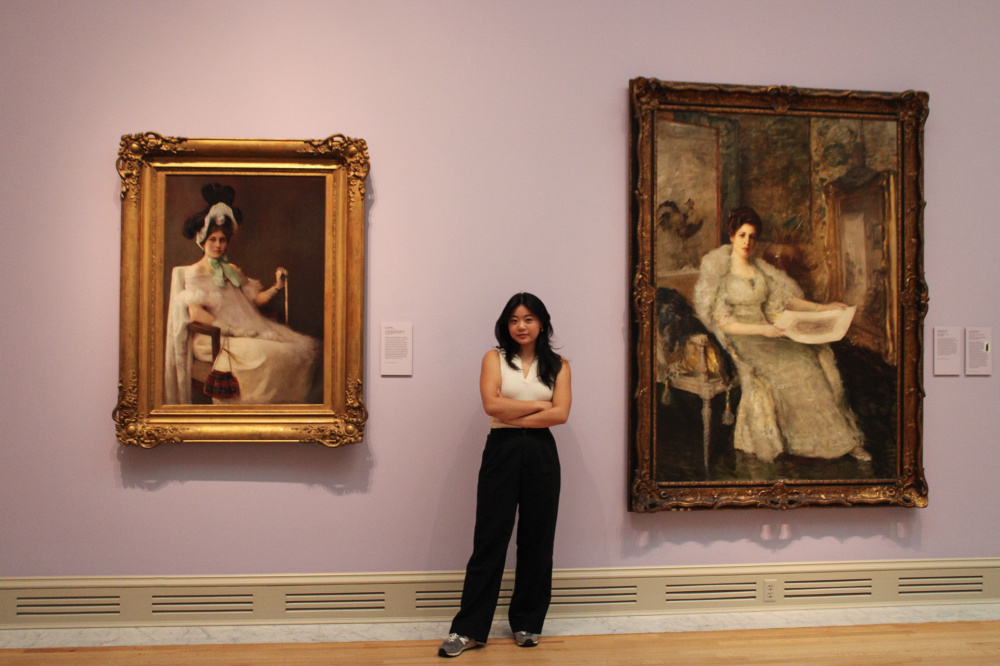- Open today, 10 am to 5 pm.
- Parking & Directions
- Free Admission
2023 Summer Interns: Sophia Kim

I have always been a huge proponent of the idea that museums are storytellers, where museums have the privilege of creating narratives and are responsible for making conscious choices to deliver this information. Growing up going to museums was one of the main ways I was exposed to American history and culture as a second-generation immigrant. My upbringing had a formative influence on how I absorbed culture and became interested in the museum industry.
My motivations were validated after speaking to the curators at the Museum about their own career paths and inspiration. The narrative mindset was reflected in the projects I worked on over the summer. My supervisor, Corey Piper, PhD, Brock Curator of American Art, reiterated the importance of highlighting and telling the stories of understudied artists, the local history, and its connections with the larger community. Each of the projects I took part in related to Norfolk and the Hamptons Roads area. To be transparent, before applying to this internship, I had only heard of the Chrysler Museum of Art in passing and had very little knowledge of the area outside of my fourth-grade Virginia history unit. One of the main projects I worked on consisted of creating artist files for an upcoming 2025 exhibition on the artist Susan Watkins and her contemporaries.
Susan Watkins moved to Norfolk with her husband, Goldsborough Serpell II in 1912. The Chrysler Museum acquired Watkins’ work after the death of her husband, making it the largest collection of her work. The exhibition aims to highlight the women who staked a claim in the academic tradition that was difficult to break through and achieve critical acclaim. It was telling how little attention was given to these women artists by the amount of research required to find even the slightest mention of these talented artists in newspapers or academic papers.

Spending my time within the American Art collection initially felt out of my comfort zone considering my interests in East Asian art for the future of my career and academic journey. The formal education of Asian art, and even more so Korean art or Asian American artists, are few and far between in Western academia. My knowledge of these fields comes from research in my free time and the array of history classes in multiple disciplines to contextualize the intersection of art, East Asian history, and the Asian diaspora. Working with American art ranging from the 19th century to 1945 gives little room to explore these interests; however, it made me more deeply consider what “American” art means and how national, ethnic, and cultural identity is perceived in America in the larger global context.
Working with American art ranging from the 19th century to 1945 gives little room to explore these interests; however, it made me more deeply consider what “American” art means and how national, ethnic, and cultural identity is perceived in America in the larger global context.
Another project I had the privilege of putting together that helped me contextualize my knowledge of Asian American history through the collection was a focused gallery exhibition on Arnold Rönnebeck, slated for this winter. Like many of the artists in the American art collection here, the interaction and exchange of ideas and culture were, and are, vital to the development of art. Many American-born artists in the Chrysler’s collection studied in Paris, while some European expatriate artists like Rönnebeck, moved to the United States and explored American culture and industry in his art. Trends and artistic styles like Impressionism, Chinoiserie, and Japonisme arose from and were influenced by trade and globalization.
While I was not able to explore this concept further in a professional capacity here, insightful conversation that I have previously had in the classroom was further expanded upon in both more casual discussions with mentors and professionals and through opportunities like attending curator talks. McKinnon Curator of Modern and Contemporary Art, Chelsea Pierce PhD, presented on the gallery rehang rooted in re-examining and de-centering the canon of Western modern art. Learning about how the museum industry is changing and hearing the theoretical conversations I have had in the classroom play out in the museum demonstrated the applicability of my education to this internship and was one of my favorite experiences this summer.
As for the more hands-on experiences, I especially enjoyed included getting to measure the gallery space, see acquired objects come into the preparatory room, and select frames for the focused Rönnebeck exhibition. In addition to learning how to write object labels and how to adapt academic writing into more accessible content for the general public, being so involved in the physical and more visible aspects of a gallery was extremely fruitful and special.
Seeing all the work that went into my very short time at the Museum and spending time behind the scenes provided me various opportunities to dip my toe into so many other departments and learn how each department is connected and essential to each other. The little trips Corey invited me to through storage, the preparatory department, and conservation opened my eyes to how integral each step of building an exhibition or collection is in telling a narrative. It was the willingness of other departments to answer my seemingly never-ending questions during these trips and information sessions that served a great deal of help in cementing my career in museums while I apply to master’s programs. Thank you to Corey for teaching me the patience and diplomacy it takes to be a curator, and to Emily Shield who eased the interns into our first museum jobs. And thank you to many others who cultivated a space where I could come out of my shell, ask my many questions, and who taught me how to advocate for myself.

